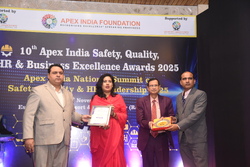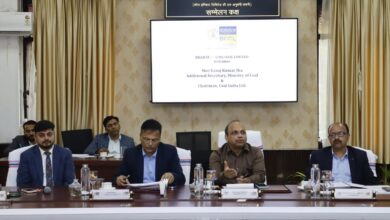India’s Growth Linked to Energy and Maritime Strength: Hardeep Singh Puri
At India Maritime Week 2025, Minister Hardeep Singh Puri highlights the vital role of energy and shipping sectors in driving India’s $4.3 trillion economy and future maritime expansion

Union Minister for Petroleum and Natural Gas, Hardeep Singh Puri, addressed the ‘Revitalizing India’s Maritime Manufacturing Conference’ held in Mumbai as part of India Maritime Week 2025, emphasizing that India’s rapid economic growth is deeply interlinked with the strength of its energy and maritime sectors.
The Minister noted that India’s GDP now stands at around USD 4.3 trillion, with nearly half originating from the external sector — including exports, imports, and remittances. This underscores the critical role of trade and shipping in India’s overall development.

Highlighting the energy sector’s dynamism, Puri said India’s crude oil consumption has risen to 5.6 million barrels per day, compared to 5 million barrels four and a half years ago, and is projected to reach 6 million barrels per day soon. According to the International Energy Agency (IEA), India is expected to account for 30 percent of the global rise in energy demand over the next two decades, up from earlier estimates of 25 percent.
He explained that the growing energy requirement would naturally increase the need for shipping capacity to transport oil, gas, and energy products worldwide. During FY 2024–25, India imported about 300 million metric tons of crude and petroleum products and exported 65 million metric tons, making the oil and gas sector the largest single commodity by volume handled at Indian ports, accounting for nearly 28 percent of total trade.
The Minister pointed out that India meets 88 percent of its crude oil and 51 percent of its gas needs through imports, emphasizing the importance of the shipping industry for national energy security. He added that Indian PSUs — IOCL, BPCL, and HPCL — have spent nearly USD 8 billion on ship charters in the past five years, an amount that could have financed a new fleet of India-owned tankers.
Currently, only 20 percent of India’s trade cargo is carried on India-flagged or India-owned vessels, highlighting both a challenge and an opportunity. To boost domestic capacity, the government is working on measures such as aggregating PSU cargo demand, introducing long-term charters for Indian carriers, advancing the Ship Owning and Leasing (SOL) model, and implementing Shipbuilding Financial Assistance Policy 2.0 with enhanced support for LNG, ethane, and product tankers.

Under Prime Minister Narendra Modi’s leadership, the maritime sector has witnessed a major transformation over the past eleven years. Port capacity has nearly doubled from 872 MTPA in 2014 to 1,681 MTPA in 2025, while cargo volumes have increased from 581 million tons to 855 million tons. Efficiency has improved with turnaround time reduced by 48% and idle time by 29%. The Sagarmala Programme has mobilized projects worth over ₹5.5 lakh crore to modernize ports and coastal infrastructure.
India’s shipyards — including Cochin Shipyard, Mazagon Dock, GRSE Kolkata, HSL Visakhapatnam, and private yards in Goa and Gujarat — are building world-class vessels. Collaborations such as Cochin Shipyard with L&T and Daewoo for LNG and ethane carriers, and partnerships with Mitsui OSK Lines, are helping infuse advanced global technologies into Indian shipbuilding.
The Minister stressed that shipbuilding requires long-term policy support and steady order pipelines to sustain infrastructure and skilled manpower. With global shipyards booked for up to six years, India should attract foreign shipbuilders to invest and build locally.
Looking ahead, Puri projected that India’s maritime sector will attract ₹8 trillion in investments and create 1.5 crore jobs by 2047. He also cited India’s growing influence on global trade routes through initiatives like the India–Middle East–Europe Economic Corridor (IMEC) and the International North-South Transport Corridor (INSTC), which link Indian ports with Europe, Central Asia, and Africa.
Concluding his remarks, Puri said that under the visionary leadership of Prime Minister Modi, India views its oceans not as barriers but as pathways to prosperity. The country is modernizing ports, building ships, promoting green shipping, and creating new employment opportunities, reaffirming India’s commitment to becoming a developed and self-reliant maritime power.




